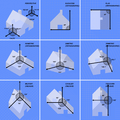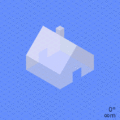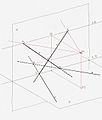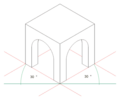3D projection facts for kids
A 3D projection is a clever way to show something that's three-dimensional (like a real object or a scene in a video game) on a flat, two-dimensional surface, such as a computer screen or a piece of paper. It helps us see depth and shape even when we're looking at a flat image.
Contents
What is 3D Projection?
Imagine you're looking at a tall building. You can see its height, width, and how far it sticks out. That's a 3D view. But if you take a photo of it, the photo is flat. A 3D projection is the process that turns that real-world 3D information into a flat picture. It makes things look like they have depth, even though they don't on the screen.
How Computers Create 3D Views
Computers use special math to figure out how to draw 3D objects on a 2D screen. They calculate where each point of an object would appear if you were looking at it from a certain angle. This is how video games and animated movies make their worlds look so real and deep.
The Idea of a Viewpoint
Think about where you are standing when you look at something. Your position changes what you see. In 3D projection, the computer pretends to have a "camera" or a "viewpoint." It then draws the object as if that camera were looking at it. If the camera moves, the projection changes, just like your view changes when you walk around an object.
Types of 3D Projections
There are different ways to project 3D objects onto a 2D surface. Each method has its own look and is used for different purposes.
Perspective Projection
Perspective projection is the most common type, especially in art and video games. It tries to copy how our eyes see the world.
- Closer objects look bigger: Just like a car looks smaller when it's far away and bigger when it's close.
- Parallel lines seem to meet: If you look down a long, straight road, the edges seem to come together in the distance. This is called a "vanishing point."
- This type of projection makes images look very realistic.
Vanishing Points Explained
A vanishing point is a spot on the horizon where parallel lines seem to meet. Imagine train tracks going straight into the distance; they look like they touch at one point. Perspective projection uses these vanishing points to create the illusion of depth. The more vanishing points used, the more complex and realistic the drawing can be.
Parallel Projection
Parallel projection is different from perspective projection because it doesn't make objects look smaller when they are farther away.
- Objects stay the same size: A cube will look the same size whether it's close or far from the "camera."
- Parallel lines stay parallel: They don't meet at a vanishing point.
- This type of projection is often used in engineering and architecture. It's good for showing exact measurements because objects don't get distorted by distance.
Axonometric Projections
Axonometric projections are a type of parallel projection. They show an object from an angle so you can see three sides at once.
- Isometric projection: This is a very common axonometric view. All three axes (length, width, height) are equally shortened, making it easy to draw and understand. It's often used in technical drawings and some video games.
- Dimetric and Trimetric projections: These are similar but shorten the axes differently, giving slightly different views.
Oblique Projections
Oblique projections are another type of parallel projection.
- One side of the object is drawn flat, facing the viewer.
- The other sides are drawn at an angle, often 30 or 45 degrees, to show depth.
- This can make one face of the object look true to size, which is helpful for certain designs.
Why are 3D Projections Important?
3D projections are super important in many areas:
- Video Games: They make game worlds feel immersive and real.
- Movies and Animation: They create believable characters and environments.
- Engineering and Design: Engineers use them to design buildings, cars, and machines, making sure everything fits together correctly.
- Medical Imaging: Doctors use 3D projections to view organs and bones from different angles.
- Virtual Reality (VR): VR headsets use 3D projection to create a feeling of being inside a different world.
By understanding how 3D projection works, we can appreciate the amazing technology that brings flat screens to life!
Images for kids
See also
 In Spanish: Proyección tridimensional para niños
In Spanish: Proyección tridimensional para niños








